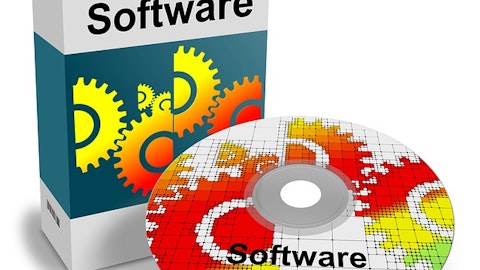Confluent, Inc. (NASDAQ:CFLT) Q3 2023 Earnings Call Transcript November 1, 2023
Confluent, Inc. misses on earnings expectations. Reported EPS is $-0.30494 EPS, expectations were $-0.01.
Shane Xie: Hi, everyone. Welcome to the Confluent Q3 2023 Earnings Conference Call. I’m Shane Xie from Investor Relations, and I’m joined by Jay Kreps, Co-Founder and CEO; and Rohan Sivaram, CFO. During today’s call, management will make forward-looking statements regarding our business, operations, sales strategy, financial performance and future prospects, including statements regarding our financial guidance for the fiscal fourth quarter of 2023, fiscal year 2023 and fiscal year 2024. These forward-looking statements are subject to risks and uncertainties, which could cause actual results to differ materially from those anticipated by these statements. Further information on risk factors that could cause actual results to differ is included in our most recent Form 10-Q filed with the SEC.

A close-up of a software programmer typing rapidly at a large monitor.
We assume no obligation to update these statements after today’s call, except as required by law. Unless stated otherwise, certain financial measures used on today’s call are expressed on a non-GAAP basis, and all comparisons are made on a year-over-year basis. We use these non-GAAP financial measures internally to facilitate analysis of financial and business trends and for internal planning and forecasting purposes. These non-GAAP financial measures have limitations and should not be considered in isolation from or as a substitute for financial information prepared in accordance with GAAP. A reconciliation between these GAAP and non-GAAP financial measures is included in our earnings press release and supplemental financials, which can be found on our IR website at investors.confluent.io.
And with that, I’ll hand the call over to Jay.
Jay Kreps: Thanks, Shane. Good afternoon, everyone, and welcome to our third quarter earnings call. We delivered a solid Q3, exceeding the high end of total revenue, operating margin and EPS guided range in a still challenging macroeconomic environment. Total revenue grew 32% to $200 million. Non-GAAP operating margin improved 22 percentage points, and non-GAAP EPS turned positive for the first time, a key milestone. We’ve now driven 36 percentage points of operating margin improvement over the last two years. I want to thank our entire employee base for the tremendous progress here. The Confluent Cloud remains the fastest-growing part of our business, with revenue up 61% to $92 million. It fell slightly below our guidance. Our Q4 revenue outlook is impacted as well.
We expect revenue growth of 21% to 22% with cloud revenue sequential add of $6 million, representing growth of 43%. The lower cloud revenue this quarter impact to guidance for Q4 is primarily driven by two factors: First, the impact from two large digital native customers. One online gaming company moved workloads back to their own data center, and one of our largest customers ramped slower as they are in the process of being acquired. We believe consumption from these two customers was impacted by their company-specific events and accounts for roughly 50% of the expected consumption shortfall for Q4. Second, the continuing macro pressure, including the ongoing conflict in the Middle East, where Israel is a top 10 country for us and the possible U.S. government shutdown, both of which add uncertainty and disruption in particular segments.
See also 11 Best Organic Food and Farming Stocks To Buy and 12 Best Asian Stocks To Buy Now.
Q&A Session
Follow Confluent Inc. (NASDAQ:CFLT)
Follow Confluent Inc. (NASDAQ:CFLT)
Receive real-time insider trading and news alerts
Specifically, we’ve seen slower organic consumption resulting from a slower rate of new use case additions in some part of our customer base. Rohan will provide more details on our resulting guidance in the later section of the call. I want to spend some time now focusing on a critical change we’re making to drive growth. Beyond just the friction in the current market environment, the critical project for Confluent is to capture the massive market opportunity in streaming. This is a $60 billion market where we are still just scratching the surface of even the existing open source Kafka usage. And we have additional expansion opportunities from Flink, our connectors and data governance, as I outlined in the earnings call last time. Critical to our execution against this opportunity is leveraging our go-to-market engine to rapidly land new customers, expand new workloads and ensure the adoption of our full set of product capabilities.
To this end, we’ll be completing the transition to orient our cloud business around consumption. This will make cloud revenue rather than bookings or committed spend the primary goal of the go-to-market organization for Confluent Cloud. This was a planned transition. Indeed, we began changes in this direction this year, but it’s a transition we’ll be significantly accelerating heading into 2024. To explain what this means, let me start with a little background. In the traditional world of on-premise software, customers would make big upfront commitments. Salespeople worked with the customer to scope these commitments and were paid as a percentage of the resulting bookings. The marketing organization measured pipeline based on these commitments, and every internal system and process was oriented around measuring and managing the bookings that resulted.
There was some misalignment between customer and vendor because customer might end up over purchasing, but this was masked by the fact that the rest of the stack, such as servers that ran the software, were also fundamentally upfront in inelastic purchases. With the advent of the cloud and the elasticity and flexibility it offered to customers, this model had to evolve. Cloud has a utility-like model where services are metered as they are used. However, in the early days, the go-to-market engine for cloud infrastructure software largely remained as it was previously, selling customer commitments or credits that overlaid this dynamic usage. Alignment between customer and vendor improved somewhat, but the vendor still had an incentive to maximally scope customer commitments.
Over the last couple of years, businesses like MongoDB, Snowflake, Datadog and hyperscalers have all transitioned their go-to-market to a fully consumption-based model. In this model, the customer and the go-to-market organization are both oriented around the actual service usage, not the upfront commitment. This fully aligns the customer value realization with the vendor’s revenue. Less obvious from the outside is how this completely upends the sales and marketing model. Pipeline is no longer oriented around maximum customer commitment, but rather new logos and new workloads. Salespeople aren’t compensated for getting an upfront booking, but rather for what a customer actually uses, finding new workloads and driving new product adoption. This is an absolute win for customers and also a huge win for vendors, who are actually able to grow faster by removing much of the uncertainty and risk from customer purchasing.
With Confluent Cloud now at nearly 50% of our revenue, having NRR over 140% and continuing rapid growth, it’s time for Confluent to complete our transition to this fully consumption-based model. We’ve already made the transition to usage-based pricing that bills for what is used. But today, our go-to-market is still primarily oriented around booking customer commitments. The final step in our consumption journey is to now fully align our go-to-market operations to the consumption motion. This directly attaches our go-to-market efforts to cloud revenue and to our customers’ value realization. This is one of the most important possible growth levers for Confluent. It is also necessary that we do this now. As we’ve seen across the industry this last year, economic pressure combined with the changing norm in cloud means customers are increasingly reluctant to make large multiyear commitments ahead of their usage.
This means over the course of this year, the misalignment between our subscription-based good market and the natural buying behavior of customers has increased, creating a drag in our cloud growth. This is shown up in the dislocation between RPO and cloud revenue, but ultimately affects both as our interaction with customers are directed in a way that is out of sync with the customers’ natural buying behavior. We believe this change will turn what is currently a drag into a tailwind. This is not a new plan for Confluent, we’d originally planned to make this shift over a three-year period beginning with steps this year. However, in light of the change we’ve seen in buying behavior, we’ll be accelerating this and completing the transition next year.
In practical terms, here’s what this means. First, beginning in Q1 of FY24, we’re shifting from our current model where 10% to 15% of cloud sales compensation is based on consumption to a model where 100% of cloud sales compensation is based on incremental consumption in new logo acquisition. We will keep the vast majority of our customer revenue under a committed contract, as we do today. However, we will not be attempting to get commitments ahead of the usage. Rather committed amounts will be customer-driven as customers choose to commit in exchange for greater discounts. Second, we’re fully orienting our field-facing teams towards landing new customers and driving new workloads with customers. Third, we’ll be adapting our product and pricing to enable customers to frictionlessly try and adopt new products, enabling easier lands and adoption of new features.
Finally, we’ll be undergoing a significant reworking of our systems for planning, growth, building and measuring pipeline and forecasting performance as all shifts drive directly off cloud revenue. A number of our cloud-oriented peers have made this transition to a very positive effect. So the path and benefits are clear. Like the transition to the cloud we began several years ago, we expect to emerge stronger on the other side, more aligned with our customers and better positioned to capture the $60 billion opportunity in front of us. In September, we held Current 2023, the only industry event dedicated to the data streaming ecosystem. It was a high-energy event and a fantastic illustration of the excitement and innovation around data streaming.
The event included speakers from BMW, NASA, Nationwide, Snowflake and Uber and many others, as well as thousands of practitioners who gathered to discuss the state of the art data stream. One of the things I’m most proud of is the velocity of product innovation the team has sustained over this last year, and I think our announcements at Current are great illustration of this. We announced a new tier of Kafka cluster, Enterprise clusters which offer many of the advantages of our dedicated clusters like private networking and enhanced security, but include instant elasticity and our served multi-tenant of our core stack. This allows a better price point for customers and significantly lower serving costs for Confluent. These lower cost clusters are perfectly aligned to our consumption transformation, since they lower the entry point price but scale up automatically as you need them.




